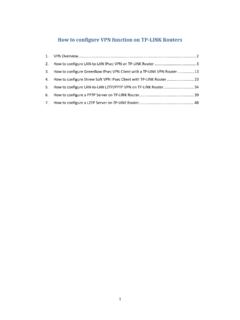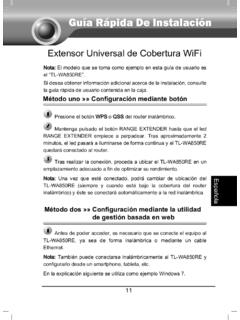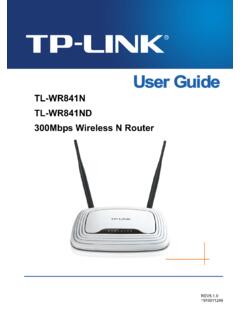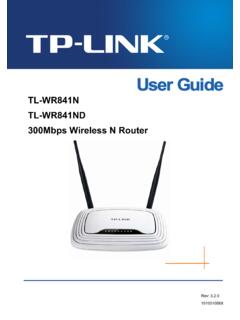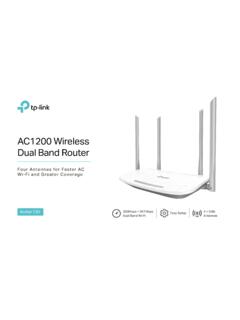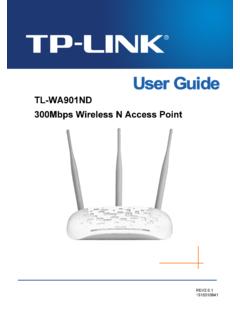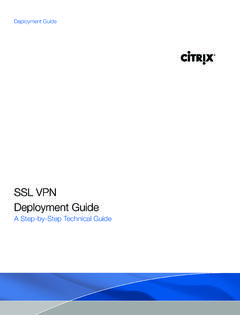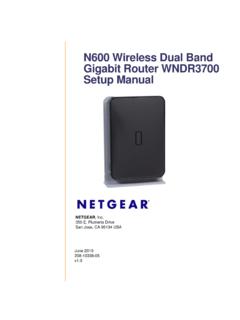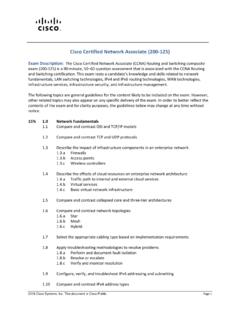Transcription of How to configure VPN function on TP-LINK Routers
1 How to configure VPN function on TP-LINK Routers 1. VPN 2. 2. How to configure LAN-to-LAN IPsec VPN on TP-LINK 3. 3. How to configure GreenBow IPsec VPN Client with a TP-LINK VPN 13. 4. How to configure Shrew Soft VPN IPsec Client with TP-LINK 23. 5. How to configure LAN-to-LAN L2TP/PPTP VPN on TP-LINK Router .. 34. 6. How to configure a PPTP Server on TP-LINK Router .. 41. 7. How to configure a L2TP Server on TP-LINK 53. 1. 1. VPN Overview VPN (Virtual Private Network) is a private network established via the public network, generally via the Internet. However, the private network is a logical network without any physical network lines, so it is called Virtual Private Network. With the wide application of the Internet, more and more data are needed to be shared through the Internet. Connecting the local network to the Internet directly, though can allow the data exchange, will cause the private data to be exposed to all the users on the Internet.
2 The VPN (Virtual Private Network) technology is developed and used to establish the private network through the public network, which can guarantee a secured data exchange. VPN adopts the tunneling technology to establish a private connection between two endpoints. It is a connection secured by encrypting the data and using point-to-point authentication. As the packets are encapsulated and de-encapsulated in the Router, the tunneling topology implemented by encapsulating packets is transparent to users. The tunneling protocols supported by TP-LINK Routers are as below: Product Model Tunneling Protocol TL-ER6120 IPsec PPTP L2TP. TL-ER6020 IPsec PPTP L2TP. TL-ER604W IPsec PPTP L2TP. TL-R600 VPN IPsec PPTP. 2. 2. How to configure LAN-to-LAN IPsec VPN on TP-LINK Router Suitable for: TL-ER6120, TL-ER6020, TL-ER604W, TL-R600 VPN. To setup an IPsec VPN tunnel on TP-LINK Routers you need to perform the following steps: A.
3 Connecting the devices together B. Verify the settings needed for IPsec VPN on router C. Configuring IPsec VPN settings on TL-ER6120 (Router A). D. Configuring IPsec VPN settings on TL-R600 VPN (Router B). E. Checking IPsec SA. NOTE: We use TL-ER6120 and TL-R600 VPN in this example, the way to configure IPsec VPN. on TL-ER6020/TL-ER604W is the same as that on TL-ER6120. A. Connecting the devices together Before setup a VPN tunnel, you need to ensure that the two Routers are connected to the Internet. After ensuring that there is an active Internet connection on each router, you need to verify the VPN settings of the two Routers , please follow the instruction below. B. Verify the settings needed for IPsec VPN on router To verify the settings needed on the two Routers , please login the router's management webpage. Router A's Status page: 3.
4 Router B's Status page: 4. C. Configuring IPsec VPN settings on TL-ER6120 (Router A). Step 1 : On the management webpage, click on VPN then IKE Proposal. Under IKE Proposal, enter Proposal Name whatever you like, select Authentication, Encryption and DH Group, we use MD5,3 DES, DH2 in this example. Step 2 : Click on Add. 5. Step 3 : Click on IKE Policy, enter Policy Name whatever you like, select Exchange Mode, in this example we use Main, select IP Address as ID Type. Step 4 : Under IKE Proposal 1, we use test1 in this example. Enter Pre-shared Key and SA. Lifetime you want, DPD is disabled. Step 5 : Click on Add. Step 6 : Click on IPsec on the left menu, then IPsec Proposal. Select Security Protocol, ESP. Authentication and ESP Encryption you want to enable on VPN tunnel. Here we use ESP, MD5 and 3 DES for example. 6. Step 7 : Click on Add.
5 Step 8 : Click on IPsec Policy, enter Policy Name whatever you like, the Mode should be LAN- to-LAN. Enter Local Subnet and Remote Subnet. Step 9 : Select WAN you use and type in Remote Gateway. In this example, the Remote Gateway is Router B's WAN IP address, Step 10 : Look for Policy Mode and select IKE. Step 11 : Under IKE Policy, we select test1 which is used. Step 12 : Under IPsec Proposal, we use ipsec1 in this example. 7. Step 13 : Look for PFS, we set NONE here, under SA Lifetime, enter 28800 or the period you want. Step 14 : Look for Status then select Activate Step 15 : Click on Add. Step 16 : Select Enable then click on Save. 8. D. Configuring IPsec VPN settings on TL-R600 VPN (Router B). Step 1 : Go to IPsec VPN -> IKE, click on Add New Step 2 : Enter Policy Name whatever you like, here we use test2. Exchange Mode, select Main.
6 Step 3 : Authentication Algorithm and Encryption Algorithm are the same with Router A, we use MD5 and 3 DES in this example. 9. Step 4 : DH Group, select DH2, the same with Router A. Step 5 : Enter Pre-share Key and SA Lifetime, make sure that they are the same with Router A. Step 6 : Click on Save. Step 7 : Click on IPsec on left side, click on Add New. Step 8 : Enter Policy Name, we use ipsec2 in this example. Step 9 : Enter Local Subnet and Remote Subnet, and then enter Remote Gateway, it's Router A's WAN IP address, 10. Step 10 : Look for Exchange mode, please select IKE, and Security Protocol, we use ESP here. Step 11 : Authentication Algorithm and Encryption Algorithm are the same with Router A, we use MD5 and 3 DES in this example. Step 12 : IKE Security Policy, we use test2 in this example. Step 13 : Look for PFS, we set NONE here, under Lifetime, enter 28800 or the period you want.
7 Step 14 : Look for Status then select Enable. Step 15 : Click on Save. Step 16 : Enable IPsec and then click on Save. E. Checking IPsec SA. Router A: Router B: 11. 12. 3. How to configure GreenBow IPsec VPN Client with a TP-LINK VPN. Router Suitable for: TL-ER6120, TL-ER6020, TL-ER604W. GreenBow IPsec VPN Client is an IPsec VPN client software developed by TheGreenBow company. It can be downloaded from download page for TL-ER6120 ( ) or official website of TheGreenBow ( ). To setup an IPsec VPN tunnel between the GreenBow IPsec VPN Client and the TP-LINK VPN. Router you need to perform the following steps: A. Make sure PCs of two sides can access to Internet B. Configuring the TP-LINK VPN Router C. Configuring the GreenBow VPN Client A. Make sure PCs of two sides can access to Internet Before setup a VPN tunnel, you need to ensure that PCs of two sides are connected to the Internet.
8 After ensuring that there is an active Internet connection on each side, you need to verify the VPN settings of the two sides, please follow the instruction below. B. Configuring the TP-LINK VPN Router Step 1: Access the router's management webpage, verify the settings needed on the router. 13. Step 2: On the management webpage, click on VPN then IKE Proposal. Under IKE Proposal, enter Proposal Name whatever you like, select Authentication, Encryption and DH Group, we use MD5, 3 DES, DH2 in this example. Step 3: Click on IKE Policy, enter Policy Name whatever you like, select Exchange Mode, in this example we use Main, select FQDN as ID Type and enter Local ID and Remote ID whatever you like, here we enter 1234 for Local ID and 4321 for Remote ID. 14. NOTE: No matter on Main mode or Aggressive mode, once the client PC is behind a NAT. device, we have to select FQDN as ID Type and the NAT device must support VPN.
9 Passthrough, otherwise the VPN tunnel can't be established. Step 4: Under IKE Proposal 1, we select 1 in this example. Enter Pre-shared Key and SA Lifetime you want, DPD is disabled. Step 5: Click on IPsec on the left menu, then IPsec Proposal. Select Security Protocol, ESP. Authentication and ESP Encryption you want to enable on VPN tunnel. Here we use ESP, MD5 and 3 DES for example. 15. Step 6: Click on IPsec Policy, enter Policy Name whatever you like, the Mode should be Client-to- LAN. Enter Local Subnet and select WAN port. Step 7: Look for Policy Mode and select IKE. Under IKE Policy, we select 123 which is used. Under IPsec Proposal, we use 123 in this example. 16. Step 8: Look for PFS, we set NONE here, under SA Lifetime, enter 28800 or the period you want. Look for Status then select Activate. Step 9: Enable IPsec and then click on Save.
10 C. Configuring the GreenBow VPN Client Step 1: Right click on VPN Configuration and click on New Phrase 1. Step 2: 17. Under Remote Gateway, enter the router's WAN IP address, the Pre-shared Key should be the same with router's, it is 123456 .on IKE section, the Encryption, Authentication and Key Group are the same with router's, we use 3 DES, MD5and DH2 here. Step 3: Go to Advanced tab, select DNS as Type of ID, and then enter 4321 for Local ID and 1234 . for Remote ID. 18. Step 4: Right click on Phase 1, add a new phrase 2. 19. Step 5: Enter remote LAN address and Subnet mask, in the example, the IP address is , Subnet mask is Encryption and Authentication are the same with Routers ; we use 3 DES and MD5 here. The Mode should be Tunnel. 20. Step 6: Click Save and Apply and then right click on Phrase 2(Tunnel), click on Open Tunnel. 21.
